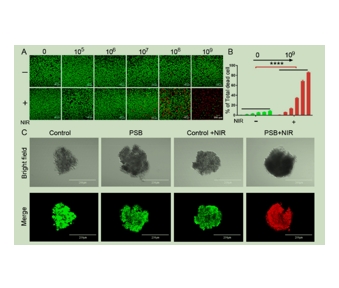文献:Self-Propelled and Near-Infrared-Phototaxic Photosynthetic Bacteria as Photothermal Agents for Hypoxia-Targeted Cancer Therapy
文献链接:https://pubmed.ncbi.nlm.nih.gov/33236885/
作者:Pengli Zheng, Miao Fan,Huifang Liu, Yinghua Zhang, Xinyue Dai, Hang Li, Xiaohan Zhou,Shiqi Hu, Xinjian Yang, Yi Jin, Na Yu, Shutao Guo, Jinchao Zhang, Xing-Jie Liang, Ke Cheng,Zhenhua Li
相关产品:RhB
原文摘要:Hypoxia can increase the resistance of tumor cells to radiotherapy and chemotherapy. However, the dense extracellular matrix, high interstitial fluid pressure, and irregular blood supply often serve as physical barriers to inhibit penetration of drugs or nanodrugs across tumor blood microvessels into hypoxic regions. Therefore, it is of great significance and highly desirable to improve the efficiency of hypoxia-targeted therapy. In this work, living photosynthetic bacteria (PSB) are utilized as hypoxia-targeted carriers for hypoxic tumor therapy due to their nearinfrared (NIR) chemotaxis and their physiological characteristics as facultative aerobes. More interestingly, we discovered that PSB can serve as a kind of photothermal agent to generate heat through nonradiative relaxation pathways due to their strong photoabsorption in the NIR region. Therefore, PSB integrate the properties of hypoxia targeting and photothermal therapeutic agents in an “all-in-one” manner, and no postmodification is needed to achieve hypoxia-targeted cancer therapy. Moreover, as natural bacteria, noncytotoxic PSB were found to enhance immune response that induced the infiltration of cytotoxicity T lymphocyte. Our results indicate PSB specifically accumulate in hypoxic tumor regions, and they show a high efficiency in the elimination of cancer cells. This proof of concept may provide a smart therapeutic system in the field of hypoxia-targeted photothermal therapeutic platforms.
RhB由于其良好的荧光特性常被用于细胞成像实验。它可以标记细胞内的各种生物分子,如蛋白质、核酸等,通过荧光显微镜观察细胞内这些分子的分布、运输和相互作用情况。例如,在研究细胞的内吞作用(endocytosis)时,可以用罗丹明 B 标记被细胞摄取的物质,追踪其在细胞内的动态变化。罗丹明 B 可以作为信号分子用于构建生物传感器。例如,当与某些生物识别元件结合后,在遇到特定的目标分子时,其荧光性质会发生变化,从而实现对目标分子的检测。PSB由于其近红外(NIR)趋化性和作为兼性需氧菌的生理特性,被用作缺氧tumorTreatment 的缺氧靶向载体。发现PSB可以作为一种光热剂,通过非辐射弛豫途径产生热。因此,PSB以“一体化”的方式整合了缺氧靶向和光热Treatment 化合物的特性,不需要后修饰来实现缺氧靶向的cancerTreatment 。

图为:体外光热Treatment
为了证实PSB的缺氧和NIR-趋光性能力,选择了来自MCF-7细胞的多细胞tumor球状体(MCTSs)来模拟实体tumor的缺氧特征。首先用1,2-二硬脂酰-sn-甘油-3-磷酸乙醇胺(DSPE)−聚乙二醇与共轭罗丹明(DSPE-PEG-RhB)标记PSB。PSB用DSPE-PEG-RhB标记,呈现出明亮的红色荧光,荧光强度随着时间的延长而增加。然后,将rhb标记的PSB与MCTSs一起孵育。结果发现,在没有NIR光的情况下,MCTSs内的红色荧光弱于MCTSs周围,而在NIR光照射下,核心强烈增强了MCTSs核心的荧光。这是由于从壳层到核心的氧浓度下降,以及PSB向NIR光移动。此外,还以直径为500 nm的rhb标记聚苯乙烯(PS)微球作为对照,发现PS的红色荧光主要分布在tumor壳周围。

图为:PSB的生物分布和缺氧靶向能力
结论:PSB特异性地聚集在缺氧的tumor区域,并且它们在清除cancer细胞方面表现出很高的效率。PSB可以利用其自我推进和NIR-趋光能力游到tumor的缺氧区域。PSB在NIR光下具有光热特性,因为从Bchl中高吸收NIR光。因此,与之前的研究结果相比,现在的研究结果消除了构建光热剂修饰bacteria的复杂构建过程,以实现tumor生长抑制。此外,PSB不仅无细胞有害性,而且由于其改善抗cancer免疫系统而对身体有益。

 2025-02-12 作者:lkr 来源:
2025-02-12 作者:lkr 来源:

